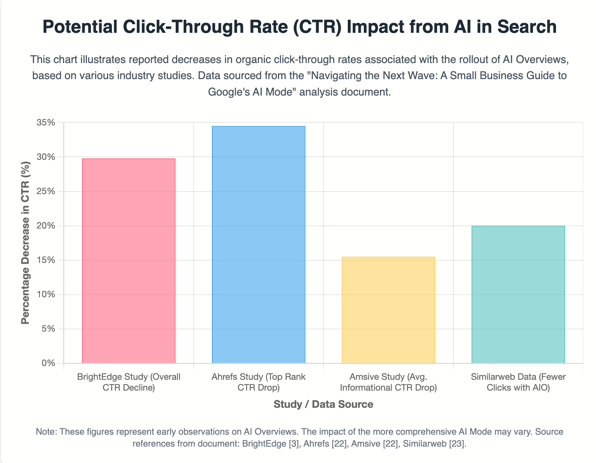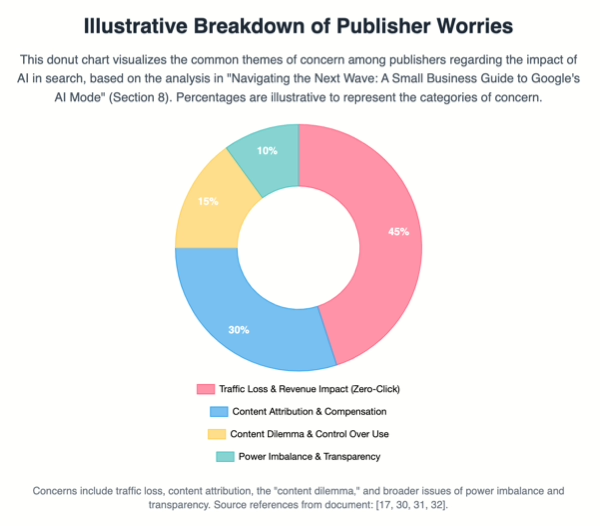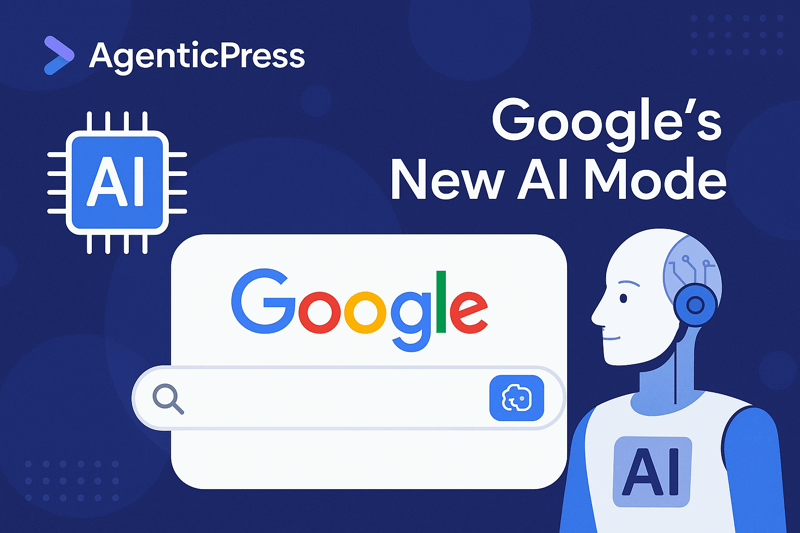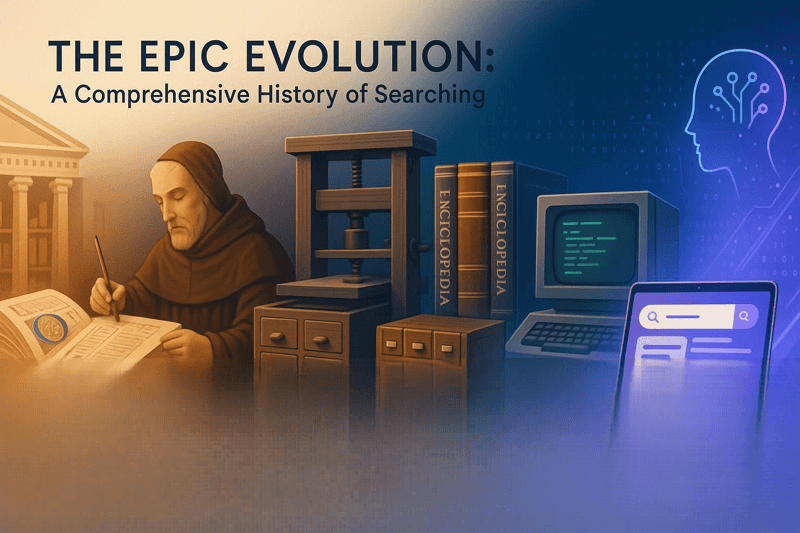Google’s New AI Mode Could Rewrite the Rules of Search Marketing
The search landscape has been dramatically transformed since Google first introduced PageRank. The recent rollout of Google’s new AI mode represents a fundamental shift in how information is discovered, presented, and consumed online. This experimental feature, powered by a custom version of Gemini 2.0, is designed to tackle complex, multi-step questions that would have previously required multiple searches. This evolution demands a new approach to maintaining visibility for marketers and business owners who have spent years optimizing for traditional search.
The stakes couldn’t be higher. As users increasingly interact with AI-generated answers rather than traditional search results, businesses that fail to adapt risk becoming invisible to potential customers. This isn’t merely another algorithm update; it’s a reimagining of the search experience that could permanently alter how businesses connect with their audiences online.
Understanding Google’s New AI Mode in 2025
Google’s new AI mode represents the next evolution of AI Overviews, which have been used by over a billion people worldwide. This experimental feature utilizes a custom version of Gemini 2.0 specifically designed to handle complex queries with nuance and depth. Unlike traditional search, which primarily matches keywords to webpages, Google’s new AI mode can understand multi-step questions, synthesize information from various sources, and deliver comprehensive answers directly within the search interface.
The scale of this transformation is already evident. In 2024 alone, Google’s AI Overviews handled nearly 60 billion search queries, which continues to grow exponentially. According to an Elon University survey, more than half of Americans have already used generative AI services like ChatGPT, Google Gemini, or similar tools, signaling rapid mainstream adoption.
What sets Google’s new AI mode apart is its advanced reasoning capabilities. Rather than simply pulling featured snippets from websites, it can analyze complex questions, break them down into logical components, and construct thorough responses that address multiple aspects of a query. This allows users to ask sophisticated questions like “Compare renewable energy policies in California versus Texas and explain their economic impacts,” and receive comprehensive answers without conducting several separate searches.
This represents the acceleration of a trend that industry experts have been tracking for years: the shift from links to answers. As this transition continues, the fundamental search success metrics are being redefined.
How Google’s New AI Mode Works
To appreciate the magnitude of change that Google’s new AI mode brings to search marketing, it’s essential to understand its technical underpinnings. Unlike traditional search algorithms that primarily match keywords to indexed webpages, Google’s new AI mode employs sophisticated natural language processing to comprehend query intent, context, and nuance.
When a user enters a complex query, the system doesn’t simply look for pages that contain matching keywords. Instead, it analyzes the question’s semantic meaning, breaks it into logical components, and draws on its vast knowledge base to construct a comprehensive response. This approach allows Google’s new AI mode to handle queries that would be nearly impossible for traditional search to address effectively.
The user experience differs dramatically as well. Instead of a standard search engine results page (SERP) with ten blue links, users receive a conversational response that directly answers their question. This response may include citations to source material, but the primary information is delivered within the AI interface. According to Search Engine Journal’s analysis, this represents a fundamental change in how users interact with search results.
Consider a complex query like “What are the long-term effects of intermittent fasting on metabolism, and how does it compare to traditional calorie restriction for weight management?” A traditional search might return scientific studies, health websites, and blog posts that users need to read and synthesize. However, Google’s new AI mode can analyze numerous sources, extract the relevant information, and present a comprehensive answer that addresses all aspects of the question, complete with supporting evidence and nuanced comparisons.
The Impact on Traditional SEO Metrics
Google’s new AI mode is disrupting conventional SEO metrics and measurement frameworks. Traditional performance indicators like click-through rates, rankings, and organic traffic are becoming less relevant as more queries are resolved directly within the AI interface.
Research from Semrush reveals that websites are experiencing significant shifts in traffic patterns following the introduction of AI-powered search features. Google’s new AI mode amplifies the concept of “zero-click searches,” where users get their answers directly on the SERP without visiting any websites. Some industries have reported that up to 30% of their traffic has been affected by AI-generated answers appearing at the top of search results.

As the chart above indicates, studies from various industry sources show significant decreases in organic click-through rates associated with AI Overviews. The impact ranges from 15% to nearly 35% CTR decline, depending on the specific study and context measured. These figures represent early observations on AI Overviews, and the impact of the more comprehensive AI Mode may be even more pronounced.
The implications are profound: high rankings may no longer guarantee visibility if AI systems can extract and present your information without sending users to your site. This challenges the foundational metrics that search marketers have relied on for decades and necessitates a new approach to measuring search success.
Winners and Losers in the AI Search Era
Not all websites will be equally affected by Google’s new AI mode. Certain types of content and businesses are better positioned to thrive in this new environment, while others face significant challenges.
Content that provides clear, authoritative, comprehensive information on specific topics performs well in AI-generated answers. Websites with strong E-E-A-T signals (Experience, Expertise, Authoritativeness, and Trustworthiness) are more likely to be cited as sources. According to research from the AI Sector Predictions, industries with high AI search adoption rates include professional services (48%), healthcare (53%), retail and e-commerce (64%), real estate (61%), and hospitality (72%).
Conversely, sites that rely heavily on user engagement, page views, or ad impressions may struggle as traffic is redirected to AI interfaces. Content farms, sites with thin content, and those optimized purely for keyword rankings rather than providing value face the greatest risk of becoming irrelevant.
Small and mid-sized businesses face particular challenges due to what could be described as a “winner-takes-all” problem. As noted in a comprehensive analysis by Higher Visibility, unlike traditional search results with multiple options, AI often provides just one main answer, mentioning only a few brands, if any. This means being “pretty good” isn’t enough; businesses must be among the best sources cited to gain visibility.
Entity recognition is crucial in determining which sources appear in AI-generated responses. Well-established brands and entities with substantial digital footprints have a natural advantage, as AI systems can more easily recognize and trust them as authoritative sources.
The Citation Economy: Being Mentioned vs. Being Visited
One of the most profound shifts brought by Google’s new AI mode is the emerging “citation economy,” where being mentioned or cited within AI-generated answers becomes as valuable as or even more beneficial than receiving direct website visits.
This represents a fundamental change in how we measure content success. Traditional metrics focused on driving traffic to websites, where visitors could be converted through various means. In the new paradigm, the value often comes from having your information cited directly within AI responses, even if users never visit your site.

As the donut chart illustrates, publishers have significant concerns about this shift. Traffic loss and revenue impact from “zero-click” searches represent the largest worry (45%), followed by content attribution and compensation issues (30%), concerns about the “content dilemma” and control over how content is used (15%), and broader issues of power imbalance and transparency (10%).
This shift has significant implications for content creators and marketers. It raises important questions about attribution, recognition, and monetization. If your content is valuable enough to be featured in AI responses, but users never visit your site, how do you capture value from that visibility?
Some publishers and businesses are already adapting by exploring new business models that capitalize on being authoritative sources rather than traffic destinations. This includes developing premium content designed for AI consumption, negotiating licensing agreements with AI providers, and repositioning as knowledge providers rather than destination sites.
Adapting Your Marketing Strategy for Google’s New AI Mode
Successful adaptation to Google’s new AI mode requires a strategic overhaul of traditional search marketing approaches. The good news is that many changes align with creating better user experiences and more valuable content.
Implementing structured data has become non-negotiable. Schema markup helps AI systems understand the context and meaning of your content, making it more likely to be featured in AI-generated responses. A case study from Schema Pros shows that MX Player saw 300x traffic growth and a 100% increase in video page views per user session within six months after implementing video schema markup.
Content formats that perform well in AI-generated responses include:
- Clear question-answer structures that directly address common queries
- Comprehensive, in-depth guides that cover topics thoroughly
- Well-organized content with logical heading structures
- Fact-based, authoritative information with proper citations
- Content that demonstrates clear E-E-A-T signals
Consider using tools that track traditional rankings and appearances in AI-generated answers to monitor your visibility in AI search results. Regular testing of relevant queries to see if your content is being cited is also a valuable practice.
For WordPress users, implementing AI Search Optimization (AISO) involves a combination of technical implementation, content restructuring, and strategic planning. This includes schema markup, semantic HTML structure, and entity relationship mapping to ensure AI systems can properly understand and represent your content.
Beyond Keywords: Entity-Based Optimization
In Google’s new AI mode, entity-based optimization replaces traditional keyword optimization. Entities are people, places, things, concepts, or ideas that AI systems can recognize and understand as distinct objects with properties and relationships.
Google’s Knowledge Graph contains billions of these entities and their relationships. To optimize for AI visibility, businesses must ensure they’re recognized as relevant entities within their industry or niche.
Practical approaches to entity optimization include:
- Clearly defining your business, products, and services using structured data
- Creating content that establishes relationships between your entity and other relevant entities
- Building consistent entity signals across the web, not just on your website
- Using authoritative sources to validate entity relationships
For example, a local restaurant should establish itself as an entity connected to its location, cuisine type, price range, signature dishes, and other relevant entities. This helps AI systems place the business in the proper context when generating responses to queries like “best Thai restaurants in Chicago with outdoor seating.”
The Future of Search in the AI Age
As Google’s new AI mode evolves, we can expect even more profound changes to the search landscape. Industry forecasts suggest that by 2026, traditional search volume could drop by 25%, with AI-powered search becoming many users’ primary mode of information discovery.
This transformation extends beyond Google. Multiple AI platforms compete to become the go-to information sources, each offering slightly different approaches to AI-powered search. This creates challenges and opportunities for businesses seeking visibility across multiple platforms.
The businesses that will thrive in this new environment view AI not as a threat but as an opportunity to rethink how they create and distribute information. By focusing on becoming authoritative sources that AI systems trust and cite, rather than simply destinations for traffic, forward-thinking organizations can maintain and even enhance their digital visibility.
Conclusion
Google’s new AI mode represents a paradigm shift in search marketing that requires fundamental strategy, measurement, and content creation adjustments. The transition from a link-based economy to a citation-based one challenges long-established practices and creates new opportunities for businesses that adapt quickly.
Success in this new landscape will come to those who:
- Optimize for AI comprehension through structured data and clear content organization
- Focus on establishing entity recognition and relationships
- Create comprehensive, authoritative content that demonstrates clear E-E-A-T signals
- Develop new metrics for measuring success beyond traditional traffic and rankings
- Continuously test and refine their approach as AI systems evolve
The time to prepare for this transformation is now. As AI becomes the primary interface between users and information, the businesses that proactively adapt their digital presence will maintain visibility. At the same time, competitors who cling to outdated approaches fade from view.
Is your business ready for the era of AI-driven search? Take the first step by analyzing your current AI search readiness and developing a strategy ensuring visibility in this rapidly evolving landscape.

